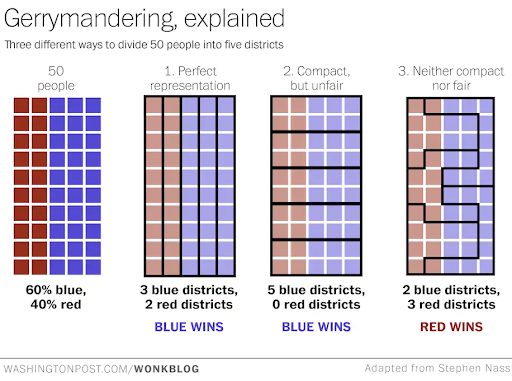Section 4.2 Understanding the Issue
What is gerrymandering? When does it happen? Why is it controversial?
Gerrymandering is the act of defining the boundaries of electoral districts to benefit a party or politician. Initial discussions of gerrymandering typically focus on the shape or geometry of districts, as these can be indicative of manipulation. How can the shape of districts affect voting outcomes, regardless of underlying population proportions? Consider the following example:

The following clip from Washington Post provides an overview of gerrymandering in the United States that elaborates on the above images.
Redistricting (in the United States) is the process of drawing new political districts (maps) every 10 years, as required by the U.S. Census. Political districts form the basis of our representative democracy, as each district corresponds to (at least one) representative in government, decided by elections among citizens living in that district.
Political districts exist at different levels of government. First, the 435 members of the U.S. House of Representatives each correspond to one district in one of the 50 states. The number of districts in each state is roughly proportional to that state's population, with the exact number determined by a mathematical algorithm known as the Huntington-Hill Method. As of the 2020 Census, the top six states in representatives are California (with 52), Texas (38), Florida (28), New York (26), Illinois (17), and Pennsylvania (17). Another six states have only a single representative (statewide district): Delaware, South Dakota, North Dakota, Alaska, Vermont, and Wyoming.
Much like the U.S. Congress is divided into a Senate and a House of Representatives, state legislatures (governments) are also divided into two “houses.” (Note: Nebraska is an exception as they are the only state with a single-house legislature.) The number of districts in state legislatures varies by state, but is also subject to decennial redistricting to account for population changes and shifts. For example, Connecticut's State Senate has 36 districts and their State House of Representatives has 151 districts. The full listings of the number of legislative districts by state is available online. [4.12.47].
There are a few rules that all states must abide by when drawing their districts:
Districts must be roughly equal in population ("one person, one vote").
Districts must be contiguous (one connected shape).
Districts must comply with racial fairness via the Voting Rights Act of 1965 (see Section 4.7 for more information).
Redistricting can be controversial due to who draws the lines in each state. While some states have independent redistricting commissions comprised of citizens or politicians equally representing the two main political parties, other states' processes are controlled by the political party in power of the state government. When in control, this incentivizes a political party to manipulate the maps in an effort to maximize their own future representation. The manipulation of drawing districts to benefit one group is called gerrymandering and will be explored mathematically and politically in this module.